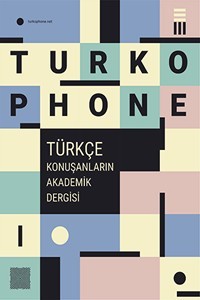Çift Dilli Çocukların Dil Gelişimi
Çift dilli çocuklar, iki dilli çocuklar, dil öğrenme
Language Development of Bilingual Children
Bilingual children, language development,
___
- Barron-Hauwaert,S.(2004). Language strategies for bilingual families. Toronto: Maltilingual Matters.
- Bee,H. (1989). The developing child. New york: Harper and Row.
- Ben Zeev, S. (1977). The influence of bilingualism on cognitive stategy. Child Development, 48, 1009-1018.
- Blasi,A. Lloyd-Fox, S. Mercure,E.Thompson, A. et al. (2011). Early specialization for voices and emotion processing. Current Biology, 21 (14), 1220-1224.
- Bono,M. (2011). Crosslinguistic interaction and metalinguistic awareness in third language acquisition. In De Angelis,Gand Dewaele,J. (eds) New Trendsin Crosslinguistic Influence and Multilingualism Research Toronto: Multilingual Matters.
- Bosch, L. and Sabestian-Galles, N. (1995). Cognitive, 2 (1), 33-69.
- Carringer, D. (1974). Creative thinking abilities of Mexican youth. Journal of Cross Cultural Study, 5, 492-504.
- Chomsky, N. (1959). Review of verbal behavior. In Language, 35, 26.
- Chomsky, N. (1986). Knowledge of language. New York: Praeger.
- Cristal, D. (1986). Listen to your child. London: Penguin.
- DeHouwer, A. (1990). The acquisition of two languages. Cambridge: Cambridge Univ. Press.
- Ellul, S. (1978). A case study in bilingualism. Cambridge: Huntinton Publishers Ltd.
- Fantini,A.E. 1985. Language acqusition of bilingual children. Clevedon. Multilingual Matters.
- Genesee, F. (1975). Communication skills in bilingual children. Child Development, 46, 1010-1014.
- Goddard, H.H. (1917). Mental tests in immigrants. Journal of Delinquency, 2, 243-277.
- Grossjean, F. (1982). Life with two languages. Massachusetts: Harward University Press.
- Harding, E, & Reilly, P. (1987). The bilingual family. Cambridge: Cambridge Univ. Press.
- Ianco-Warrall, A, (1972) Bilingualism and cognitive development. Child Development, 43, 1390- 1400.
- Jespersen, 0. (1922). Language. London: George Allen & Unwin Ltd.
- Lambert, W. E. (1977).The effects of bilingualism on the individual. New York: Academic Press.
- Liedtke, W. (1968). Concept formation and bilingualism. Alberta Journal of Educational Research. 14. 225-232.
- Machado, J. (2003). Early Childhood Experiences in Language Arts: Emergent Literacy. Canada: Thomson Delmar Learning.
- Macnamara,J. (1970). Bilingualism and thought.Bilingualism and Language Contact. Washington D.C.: Georgetown University.
- Mackey, W. F. (1962). The discription of bilingualism. Canadian Journal of Linguistics, 7(51), 8.
- Meisel, J. (1986). Word order. Linguistics, 24, 123- 183.
- Mills, M. And Melhuish,E. (1974). Recognition of mother‟s voice in early infancy. In Nature, 252, 123.
- Romaine, S. (1991). Bilingualism. Oxford: Basil Blackwell Inc.
- Saunders, G. (1982). Bilingual children. England: Multilingual Matters.
- Scientific Learning Corporation. (1999). www. Brain connection.com.
- Scott, S. (1973). The relation of divergent thinking on bilingualism. Unpublished report. Mc Gill University.
- Skinner, B.F. (1957). Verbal behavior. New York: Appleton-Century-Crofts.
- Spolsky, B. (1989). Conditions for second language learning. Oxford: Oxford Univ. Press.
- Zierer, E. (1977). Experiences in bilingual education. International Review of Applied Linguistics, 15,144-149.
- ISSN: 2148-6808
- Başlangıç: 2014
- Yayıncı: Bekir İNCE
Why to Involve Teachers in the Process of Language Curriculum Development?
Çift Dilli Çocukların Dil Gelişimi
8-10. SINIF “TÜRKÇE VE TÜRK KÜLTÜRÜ”DERS KİTABININ HEDEF YAŞ DÜZEYİNE UYGUNLUĞU
Bilgisayar Oyun Dergileri ve Yabancı Dil Olarak Türkçenin Öğretimi
TÜRKÇE ÖĞRENEN YABANCI UYRUKLU ÖĞRENCİLERİN DERS ÇALIŞMA ÖZYETERLİK ALGISI VE UYGULAMA ÖRNEĞİ
Yabancı Dil Olarak Türkçe Öğretimi
Extra G. ve Yağmur K. (2013) Dil Zengini Avrupa, Cambridge Üniversitesi Yayınevi
